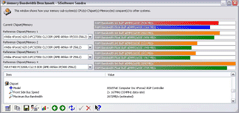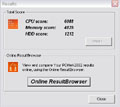|
 Posted: June 18, 2003 Posted: June 18, 2003
Author: Jason Kohrs
Manufacturer: Geil
Source: N/A (Search PriceGrabber for Best Deal)
Although nForce2 motherboards do utilize dual channel DDR, they have proven to be less than ideal for benchmarking memory. The nForce2 chipset does not communicate data to Windows based applications such as SiSoft Sandra or CPU-Z (pictured below) that could provide the user with confirmation of the timings and speeds set in the BIOS. The grayed out areas below would be fully populated with data on a new 875P Pentium 4 motherboard, for example, and just provides assurance that the results are valid. In addition to the more complete data reporting, the results from benchmarks run on a Pentium 4 system blow away the results achieved on a nForce2 based system.
 |
Regardless, the tests were run at various speeds, with all settings logged manually. The first test was run at the default speed of 133 MHz frontside bus / 400 MHz DDR memory, and SPD detected the advertised timings of CAS 2 6-3-3 as referenced in the CPU-Z screen capture above. From this point, I then worked my way up to the maximum synchronous speed (where the memory runs at the same speed as the frontside bus), as well as the maximum asynchronous speed (highest memory speed regardless of frontside bus). Greater overall system performance is achieved when the frontside bus and the memory are synchonized, so these results are of interest, but to truly test the maximum speed of the Geil PC3200 I know it will have to set the two asynchronously.
Due to limitations with my cpu, or perhaps my overclocking skills, the maximum (stable) forntside bus achieved was 180 MHZ. Not a bad increase over the default 133 MHz, but not nearly high enough to thoroughly test the PC3200 DDR while synchronized with the frontside bus. Synchronous results on both benchmarks were logged at 140, 150, 160, 166, 170, 175, and 180 MHZ, and then I began to test asynchronously.
After logging a few standard asynchronous results at the rated speed of the memory (133/400, 150/400, and 166/400) I began to push the speed of the memory over 400 MHz DDR. Starting with a fsb of 166, I adjusted the “Memory Frequency Percentage” and the frontside bus settings in my BIOS to slowly work the speed up until I could go no higher. After successful benchmarks were recorded at 420, 430, 444, 450, and 466 MHZ DDR, the Geil PC3200 hit the wall at what I would consider a very impressive speed of 480 MHZ DDR! Timings were maintained at 6-3-3 through all tests, and all tests above 420 MHz DDR required the CAS latency to be dropped from 2.0 to 2.5 and the DDR Voltage to be increased from 2.7V to 2.8V. Looking back at the list of DDR memory speeds on the first page, you can see that hitting 480 MHz DDR makes this faster than PC3700... not bad, not bad at all!
Since I can’t confirm the settings / timings while in Windows, I feel obliged to share the following screen shots.
The picture below details the BIOS screen with the settings used for the maximum overclock to 480 MHz DDR...
The picture below details that upon reboot the settings were all still good on our way into Windows.
Once into Windows, the two benchmarks were then documented at the maximum speed (see images below)... As well as various others which are covered in greater detail later.
 
Please read on to page 3 for the rest of the testing, as well as the conclusion... Next
Page 1 | Page 2 | Page 3 | Review Index
|